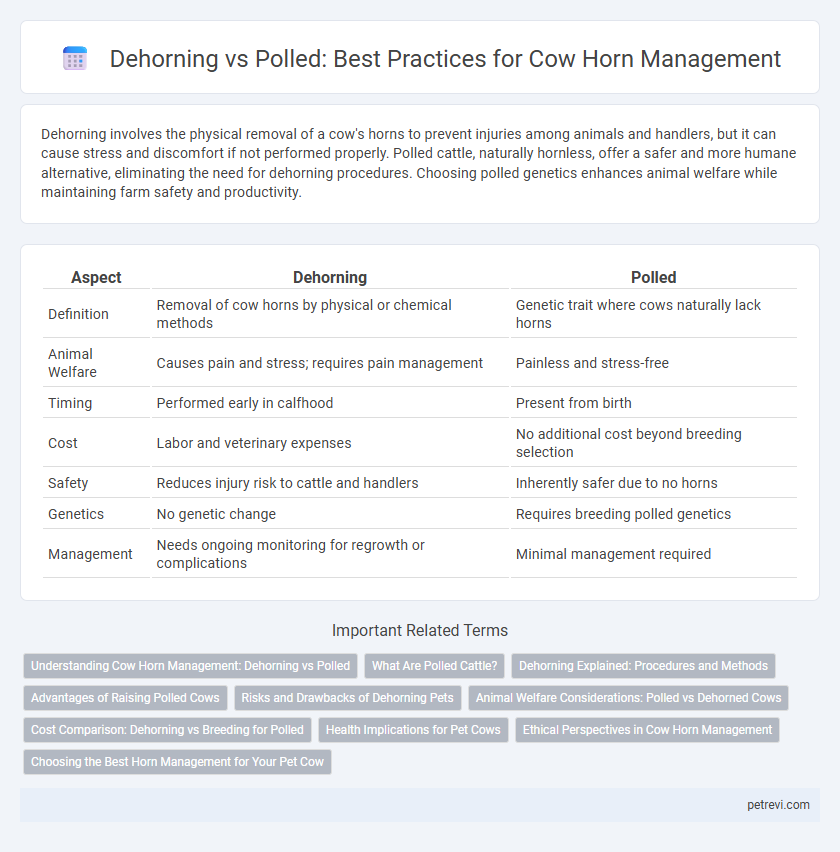Dehorning involves the physical removal of a cow's horns to prevent injuries among animals and handlers, but it can cause stress and discomfort if not performed properly. Polled cattle, naturally hornless, offer a safer and more humane alternative, eliminating the need for dehorning procedures. Choosing polled genetics enhances animal welfare while maintaining farm safety and productivity.
Table of Comparison
| Aspect | Dehorning | Polled |
|---|---|---|
| Definition | Removal of cow horns by physical or chemical methods | Genetic trait where cows naturally lack horns |
| Animal Welfare | Causes pain and stress; requires pain management | Painless and stress-free |
| Timing | Performed early in calfhood | Present from birth |
| Cost | Labor and veterinary expenses | No additional cost beyond breeding selection |
| Safety | Reduces injury risk to cattle and handlers | Inherently safer due to no horns |
| Genetics | No genetic change | Requires breeding polled genetics |
| Management | Needs ongoing monitoring for regrowth or complications | Minimal management required |
Understanding Cow Horn Management: Dehorning vs Polled
Dehorning is a common practice involving the removal of cow horns to prevent injury and facilitate handling, but it can cause stress and pain without proper management. Polled cattle, genetically hornless, offer a natural alternative that eliminates the need for dehorning while enhancing animal welfare and farm safety. Selecting polled genetics aligns with sustainable livestock management by reducing labor, improving handling safety, and meeting welfare standards.
What Are Polled Cattle?
Polled cattle are naturally hornless bovines that genetically lack horns, eliminating the need for dehorning procedures. This genetic trait enhances animal welfare by reducing injury risks associated with horns and decreases management labor and costs for farmers. Selecting polled genetics in breeding programs promotes safer handling environments and supports sustainable livestock management practices.
Dehorning Explained: Procedures and Methods
Dehorning in cows involves removing or preventing horn growth through methods such as chemical cauterization, hot iron dehorning, or surgical removal, typically performed within the first few weeks of calf life. The procedure reduces injury risks to handlers and other cattle, enhancing safety and welfare in dairy and beef operations. Proper pain management, including local anesthesia and analgesics, is essential for minimizing animal distress during and after dehorning.
Advantages of Raising Polled Cows
Raising polled cows eliminates the need for dehorning, reducing stress and potential injury to both animals and handlers. Polled cattle improve herd safety by minimizing horn-related injuries, enhancing overall animal welfare. Additionally, polled genetics streamline management practices, increasing efficiency and lowering labor costs in cattle operations.
Risks and Drawbacks of Dehorning Pets
Dehorning cows poses significant risks such as pain, stress, and potential infections, which can negatively impact animal welfare. Unlike polled cattle that are naturally hornless, dehorning requires surgical or chemical procedures that may lead to complications including bleeding and prolonged healing time. These drawbacks highlight the importance of considering genetic polled traits to avoid the health challenges associated with dehorning practices in livestock management.
Animal Welfare Considerations: Polled vs Dehorned Cows
Polled cattle, naturally hornless, eliminate the pain and stress associated with dehorning procedures, promoting better animal welfare by avoiding tissue damage and infection risks. Dehorning, while common, involves physical or chemical methods that cause acute and sometimes chronic pain, raising ethical concerns in livestock management. Selecting polled genetics improves herd safety without compromising cow health, aligning with animal welfare standards and reducing the need for painful interventions.
Cost Comparison: Dehorning vs Breeding for Polled
Dehorning incurs immediate costs including labor, veterinary fees, and potential weight loss due to stress, averaging $5 to $10 per calf. Breeding for polled genetics involves upfront investment in purchasing or artificial insemination with polled sires but reduces long-term expenses related to horn management and injury prevention. Over time, polled breeding proves more cost-effective by eliminating repetitive dehorning procedures and improving animal welfare, resulting in lower overall operational costs.
Health Implications for Pet Cows
Dehorning pet cows reduces injury risks but can cause pain, stress, and potential infection if not performed properly. Polled genetics eliminate horns naturally, preventing complications associated with dehorning and promoting better long-term health. Choosing polled cows enhances welfare by avoiding surgical procedures and reducing behavioral issues linked to horned animals.
Ethical Perspectives in Cow Horn Management
Dehorning involves removing developing horns to reduce injury risk but raises ethical concerns regarding animal pain and stress during the procedure. Polled cattle, naturally hornless due to genetic traits, present a welfare-friendly alternative by eliminating the need for dehorning. Ethical perspectives prioritize minimizing animal discomfort and promoting genetic selection for polled traits in sustainable horn management practices.
Choosing the Best Horn Management for Your Pet Cow
Selecting the best horn management for your pet cow requires understanding the benefits of dehorning versus choosing polled cattle. Dehorning, the removal of horns in young calves, reduces injury risk but can cause temporary stress and requires proper pain management. Opting for polled breeds eliminates horn growth naturally, promoting safer handling and fewer health concerns over the animal's lifetime.
Dehorning vs Polled for Cow horn management Infographic

 petrevi.com
petrevi.com